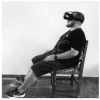Approach to Knee Arthropathy through 180-Degree Immersive VR Movement Visualization in Adult Patients with Severe Hemophilia: A Pilot Study
- PMID: 36294536
- PMCID: PMC9605271
- DOI: 10.3390/jcm11206216
Approach to Knee Arthropathy through 180-Degree Immersive VR Movement Visualization in Adult Patients with Severe Hemophilia: A Pilot Study
Abstract
(1) Background: Hemarthrosis is a typical clinical manifestation in patients with hemophilia. Its recurrence causes hemophilic arthropathy, characterized by chronic joint pain. Watching movement recorded from a first-person perspective and immersively can be effective in the management of chronic pain. The objective of this study was to evaluate the effectiveness of an immersive virtual reality intervention in improving the pain intensity, joint condition, muscle strength and range of motion in patients with hemophilic knee arthropathy. (2) Methods: Thirteen patients with hemophilic knee arthropathy were recruited. The patients wore virtual reality glasses and watched a flexion-extension movement of the knee on an immersive 180° video, recorded from a first-person perspective over a 28-day period. The primary variable was the pain intensity (visual analog scale). The secondary variables were the joint status (Hemophilia Joint Health Score), quadriceps and hamstring strength (dynamometry), and range of motion (goniometry). (3) Results: After the intervention period, statistically significant differences were observed in the intensity of the joint pain (Standard error [SE] = 19.31; 95% interval confidence [95%CI] = -1.05; -0.26), joint condition (SE = 18.68; 95%CI = -1.16; -0.52) and quadriceps strength (SE = 35.00; 95%CI = 2.53; 17.47). We found that 38.46% and 23.07% of the patients exhibited an improvement in their quadriceps muscle strength and joint condition above the minimum detectable change for both variables (8.21% and 1.79%, respectively). (4) Conclusions: One hundred and eighty degree immersive VR motion visualization can improve the intensity of joint pain in patients with hemophilic knee arthropathy. An intervention using immersive virtual reality can be an effective complementary approach to improve the joint condition and quadriceps strength in these patients.
Keywords: hemophilia; joint pain; knee; physiotherapy; virtual reality exposure therapy.
Conflict of interest statement
The authors declare no conflict of interest. The funders had no role in the design of the study; in the collection, analyses, or interpretation of data; in the writing of the manuscript; or in the decision to publish the results.
Figures
Similar articles
-
180-degree immersive VR motion visualization in the treatment of haemophilic ankle arthropathy.Haemophilia. 2023 Jan;29(1):282-289. doi: 10.1111/hae.14683. Epub 2022 Oct 19. Haemophilia. 2023. PMID: 36261396 Free PMC article.
-
One Session Effects of Knee Motion Visualization Using Immersive Virtual Reality in Patients with Hemophilic Arthropathy.J Clin Med. 2021 Oct 14;10(20):4725. doi: 10.3390/jcm10204725. J Clin Med. 2021. PMID: 34682847 Free PMC article.
-
Foam roller-based self-induced myofascial therapy in patients with hemophilic knee arthropathy: a multicenter, single-blind, randomized clinical study.Eur J Phys Rehabil Med. 2023 Dec;59(6):763-771. doi: 10.23736/S1973-9087.23.07944-3. Epub 2023 Oct 23. Eur J Phys Rehabil Med. 2023. PMID: 37869759 Free PMC article. Clinical Trial.
-
Primary total knee arthroplasty in hemophilic arthropathy.EFORT Open Rev. 2023 Nov 1;8(11):830-840. doi: 10.1530/EOR-23-0101. EFORT Open Rev. 2023. PMID: 37909693 Free PMC article. Review.
-
Joint lavage followed by intra-articular injection of hyaluronic acid and/or corticosteroids in patients with severe hemophilic arthropathy of the knee: Is this intervention really effective?Expert Rev Hematol. 2018 Jun;11(6):449-454. doi: 10.1080/17474086.2018.1472568. Epub 2018 May 10. Expert Rev Hematol. 2018. PMID: 29722575 Review.
Cited by
-
Adolescents with hemophilic knee arthropathy can improve their gait characteristics, functional ability, and physical activity level through kinect-based virtual reality: A randomized clinical trial.Heliyon. 2024 Mar 19;10(7):e28113. doi: 10.1016/j.heliyon.2024.e28113. eCollection 2024 Apr 15. Heliyon. 2024. PMID: 38560162 Free PMC article.
-
The haemophilia joint health score for the assessment of joint health in patients with haemophilia.Haemophilia. 2024 Nov;30(6):1265-1271. doi: 10.1111/hae.15116. Epub 2024 Nov 4. Haemophilia. 2024. PMID: 39494972 Free PMC article. Review.
References
-
- Soucie J.M., Cianfrini C., Janco R.L., Kulkarni R., Hambleton J., Evatt B., Forsyth A., Geraghty S., Hoots K., Abshire T., et al. Joint range-of-motion limitations among young males with hemophilia: Prevalence and risk factors. Blood. 2004;103:2467–2473. doi: 10.1182/blood-2003-05-1457. - DOI - PubMed
-
- Manco-Johnson M.J., Abshire T.C., Shapiro A.D., Riske B., Hacker M.R., Kilcoyne R., Ingram J.D., Manco-Johnson M.L., Funk S., Jacobson L., et al. Prophylaxis versus Episodic Treatment to Prevent Joint Disease in Boys with Severe Hemophilia. N. Engl. J. Med. 2007;357:535–544. doi: 10.1056/NEJMoa067659. - DOI - PubMed
-
- St-Louis J., Abad A., Funk S., Tilak M., Classey S., Zourikian N., McLaughlin P., Lobet S., Hernandez G., Akins S., et al. The Hemophilia Joint Health Score version 2.1 Validation in Adult Patients Study: A multicenter international study. Res. Pract. Thromb. Haemost. 2022;6:e12690. doi: 10.1002/rth2.12690. - DOI - PMC - PubMed
Grants and funding
LinkOut - more resources
Full Text Sources


